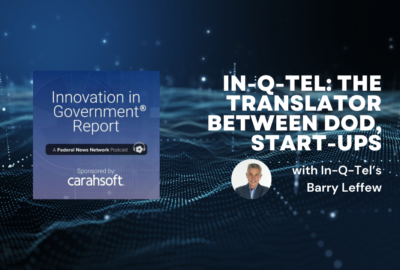Insight by In-Q-Tel
In-Q-Tel: The translator between DoD, start-ups
Barry Leffew, the vice president of the government platform accelerator at In-Q-Tel, said areas like cybersecurity, enterprise technology, space, lightweight energy...
The rate of change in the technology market can make anyone’s head spin.
The continued growth and acceptance of artificial intelligence, machine learning and predictive analytics is something the technology community hasn’t seen before.
Add to that, the developments in pushing compute to the edge and the technology sector will continue its whirlwind of change.
The Defense Department and the Intelligence Community must do more to take advantage of all the innovation happening.
One key piece to that preparation is the budget. The Defense Department’s proposed budget for fiscal 2024 includes $145 billion for research and development and $170 billion for procurement. It’s what DoD called a clear indication of its commitment to stay on the cutting edge.
The IC mapped out a four-year investment strategy for emerging technologies in 2022. Its plan shifts how the IC tracks research and development to ensure there is more of a connection to mission goals across the IC.
Barry Leffew, the vice president of the government platform accelerator at In-Q-Tel, also known as IQT, said for DoD, the IC and all national security agencies to take even more advantage of emerging technologies and position their missions for the future, they must be prepared for the impact of artificial intelligence and machine learning.
“We’re seeing a cross connection between AI and ML that is driving advances in other areas such as energy and battery technology, helping enable advances in biotechnology as well as cyber,” Leffew said on Innovation in Government sponsored by Carahsoft. “Together they’re creating an even more flywheel effect to help accelerate the growth of innovation.”
Of course, it’s not all about AI and ML. IQT, which has played a key role over the last 25 years to bring innovative technologies to the national security space through directed investments, is paying close attention to other areas like cybersecurity, enterprise technology, space and the whole trend toward commercializing space as well as more lightweight energy sources and biotechnology.
AI as the enabler
Leffew said that there is so much focus on AI/ML, however, because of how these emerging technologies are acting as strong enablers for cyber or energy or biotechnology innovations.
“Take enterprise technology, for example, it’s advancing in terms of our ability to process and store massive amounts of data and information, being able to then layer AI enables us to do faster and analysis, support decision making and actually identify new ways of solving problems,” he said. “Then AI also becomes a key enabler of cyber because of its ability to rapidly detect and respond to cyber threats.”
DoD already is investing heavily in new cyber tools through its zero trust architecture, but with the ever-changing cyber landscape, the Pentagon is always seeking better and faster tools.
Leffew said one area IQT is seeing a lot of interest in is using cyber tools to fully understand what devices are connected to the network, how they’re connected, what versions of software and firmware those tools are using. That way, Leffew said, if there is a deficiency, DoD can, through the AI tool, rapidly address vulnerabilities.
“Another area is basically what’s called the software bill of materials (SBOM) and really identifying what components are in either government-off-the-shelf (GOTS) or commercial-off-the-shelf (COTS) software, so the government can have a firm understanding of any underlying vulnerabilities,” he said. “Finally, another area is really leveraging AI right to be more reactive, and proactively identify threats that are incoming to help accelerate the ability to respond.”
Quantum is on the horizon
Leffew said IQT’s main focus is to find “dual use technologies,” where advances in commercial technology can be applied to the DoD and national security agencies.
“I think DoD is doing an excellent job of communicating their requirements. We can always do more, but what we’re really positioned to do is to be that bridge between the national security community and the startups,” he said. “There’s sometimes a translation challenge. We are taking the Federal Acquisition Regulations and Defense FARs and converting those to the world of venture capital. IQT is in a very unique position to help translate or help explain to each side how to how to best work with each other.”
One area where IQT, which the CIA created in the 1990s is trying to help with that translation is with quantum computing.
Leffew said IQT understands that quantum represents what could be a very fundamental and incredible change to public and private infrastructure.
“It really could change the way that encryption is done, and will require potentially dramatic changes to the way that we encrypt and protect information,” he said. “Another is material science, using AI to create new and improved materials. And then another area is biotechnology. Luckily, COVID is pretty much in the rearview mirror, but we, as a country, want to be prepared, that if another crisis emerges that we’re better prepared to deal with it in the future.”
Leffew said IQT believes the government is on the cusp of using quantum in limited ways.
“One of the most important things for us is to really address what’s called post quantum encryption, which is to be able to make sure that our encryption devices can’t be broken by our adversaries quantum computers,” he said. “That’s a really big area of focus right now. We are seeing the testing and development of quantum computers, not only very specialized computers, but figuring out how to miniaturize them how to bring a quantum computer so that it can be stored in a standard data center and processed in a regular type of data center environment.”
Listen to the full show:
Copyright © 2025 Federal News Network. All rights reserved. This website is not intended for users located within the European Economic Area.
Jason Miller is executive editor of Federal News Network and directs news coverage on the people, policy and programs of the federal government.
Follow @jmillerWFED
Related Stories
-

Barry Leffew
Vice President, Government Platform Accelerator, In-Q-Tel
-

Jason Miller
Executive Editor, Federal News Network
Upcoming Events
Related Stories
Top Stories

Barry Leffew
Vice President, Government Platform Accelerator, In-Q-Tel

Jason Miller
Executive Editor, Federal News Network





